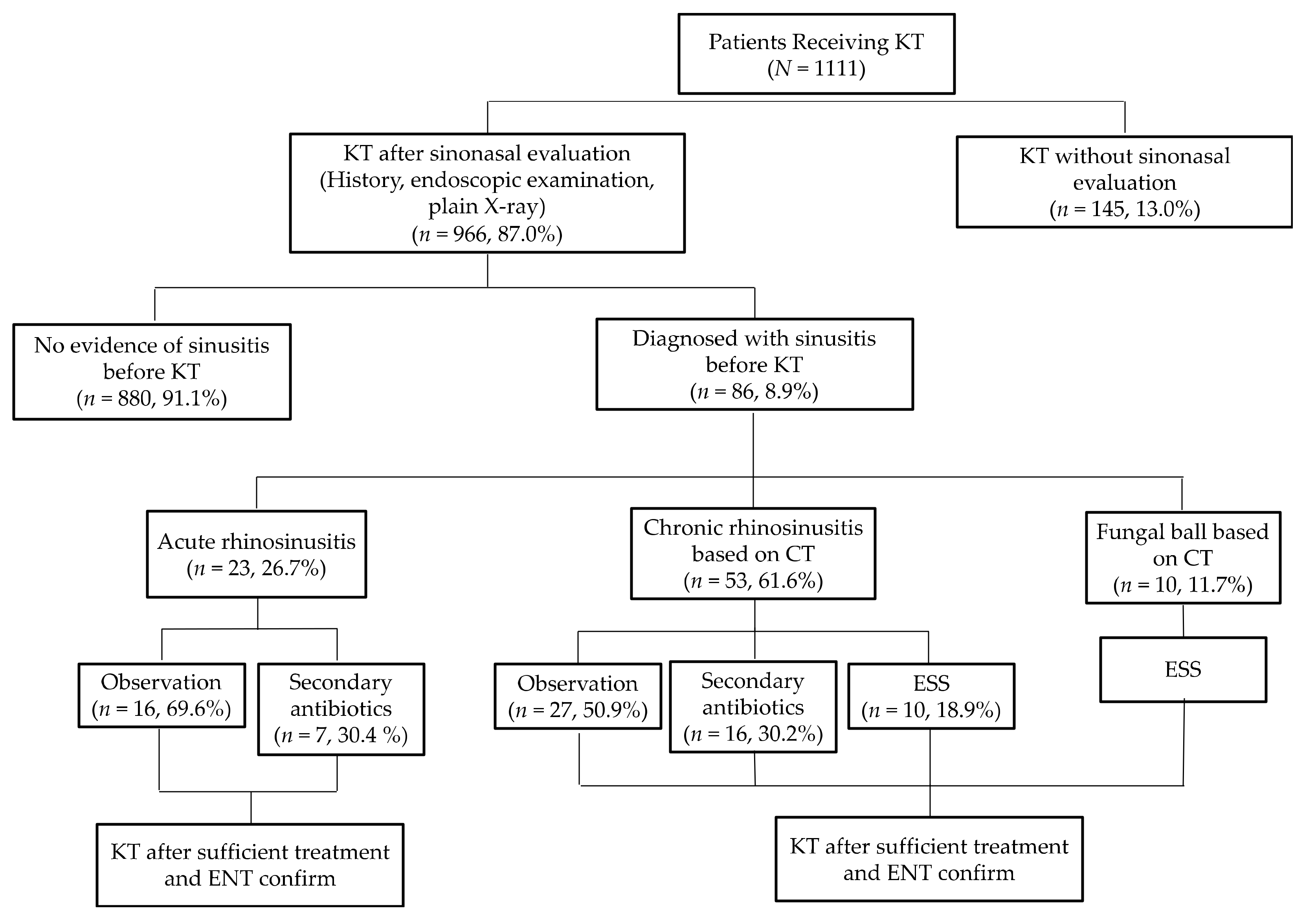Incidence and Treatment Outcome of Rhinosinusitis before Kidney Transplantation: A Retrospective Cohort Study
Abstract
:1. Introduction
2. Materials and Methods
2.1. Study Population
2.2. Protocol and Procedure for Sinonasal Evaluation and Treatment
2.3. Immunosuppressant Therapy for KT Recipients
2.4. Statistical Analyses
3. Results
4. Discussion
Author Contributions
Funding
Institutional Review Board Statement
Informed Consent Statement
Data Availability Statement
Conflicts of Interest
References
- Thompson, A.M.; Couch, M.; Zahurak, M.L.; Johnson, C.; Vogelsang, G.B. Risk factors for post-stem cell transplant sinusitis. Bone Marrow Transplant. 2002, 29, 257–261. [Google Scholar]
- Shibuya, T.Y.; Momin, F.; Abella, E.; Jacobs, J.R.; Karanes, C.; Ratanatharathorn, V.; Sensenbrenner, L.L.; Lum, L.G. Sinus disease in the bone marrow transplant population: Incidence, risk factors, and complications. Otolaryngol. Head Neck Surg. 1995, 113, 705–711. [Google Scholar]
- Won, Y.W.; Yi, S.Y.; Jang, J.H.; Kim, K.; Kim, S.J.; Kim, W.S.; Jung, C.W.; Kim, D.H. Retrospective analysis of paranasal sinusitis in patients receiving hematopoietic stem cell transplantation. Int. J. Hematol. 2011, 93, 383–388. [Google Scholar]
- Bento, L.R.; Ortiz, E.; Nicola, E.M.; Vigorito, A.C.; Sakano, E. Sinonasal disorders in hematopoietic stem cell transplantation. Braz. J. Otorhinolaryngol. 2014, 80, 285–289. [Google Scholar]
- Dhong, H.J.; Lee, J.C.; Ryu, J.S.; Cho, D.Y. Rhinosinusitis in transplant patients. Clin. Otolaryngol. Allied Sci. 2001, 26, 329–333. [Google Scholar]
- Drozd-Sokolowska, J.E.; Sokolowski, J.; Wiktor-Jedrzejczak, W.; Niemczyk, K. Sinusitis in patients undergoing allogeneic bone marrow transplantation—A review. Braz. J. Otorhinolaryngol. 2017, 83, 105–111. [Google Scholar]
- Hong, S.D.; Jang, M.S.; Cho, H.J.; Kim, H.Y.; Dhong, H.J.; Chung, S.K.; Joh, J.W. Sinonasal evaluation and treatment before liver transplantation: A retrospective review of 982 patients. Eur. Arch. Oto-Rhino-Laryngol. 2015, 272, 897–903. [Google Scholar]
- Moon, B.J.; Han, J.H.; Jang, Y.J.; Lee, B.J.; Chung, Y.S. Effect of chronic rhinosinusitis on liver transplant patients. Am. J. Rhinol. Allergy 2009, 23, 492–496. [Google Scholar]
- Lyu, J.; Lee, S.G.; Hwang, S.; Lee, S.O.; Cho, O.H.; Chae, E.J.; Lee, S.D.; Kim, W.S.; Kim, D.S.; Shim, T.S. Chest computed tomography is more likely to show latent tuberculosis foci than simple chest radiography in liver transplant candidates. Liver Transplant. 2011, 17, 963–968. [Google Scholar]
- Choi, B.H.; Han, D.J. Ongoing higher infection rate in abo-incompatible kidney transplant recipient: Is it a serious problem? A single-center experience. Ann. Surg. Treat. Res. 2016, 91, 37–44. [Google Scholar]
- Rosenfeld, R.M.; Andes, D.; Bhattacharyya, N.; Cheung, D.; Eisenberg, S.; Ganiats, T.G.; Gelzer, A.; Hamilos, D.; Haydon, R.C., 3rd; Hudgins, P.A.; et al. Clinical practice guideline: Adult sinusitis. Otolaryngol. Head Neck Surg. 2007, 137, S1–S31. [Google Scholar]
- Lund, V.J.; Kennedy, D.W. Staging for rhinosinusitis. Otolaryngol. Head Neck Surg. 1997, 117, S35–S40. [Google Scholar]
- Lund, V.J.; Mackay, I.S. Staging in rhinosinusitus. Rhinology 1993, 31, 183–184. [Google Scholar]
- Moeller, C.W.; Martin, J.; Welch, K.C. Sinonasal evaluation preceding hematopoietic transplantation. Otolaryngol. Head Neck Surg. 2011, 144, 796–801. [Google Scholar]
- Billings, K.R.; Lowe, L.H.; Aquino, V.M.; Biavati, M.J. Screening sinus ct scans in pediatric bone marrow transplant patients. Int. J. Pediatr. Otorhinolaryngol. 2000, 52, 253–260. [Google Scholar]
- Ryu, G.; Seo, M.Y.; Lee, K.E.; Kim, H.Y.; Dhong, H.J.; Chung, S.K.; Hong, S.D. Clinical course of rhinosinusitis and efficacy of sinonasal evaluation in kidney transplant recipients: Review of 1589 patients. Eur. Arch. Oto-Rhino-Laryngol. 2018, 275, 1183–1188. [Google Scholar]
- Kim, Y.S.; Kim, N.H.; Seong, S.Y.; Kim, K.R.; Lee, G.B.; Kim, K.S. Prevalence and risk factors of chronic rhinosinusitis in Korea. Am. J. Rhinol. Allergy 2011, 25, 117–121. [Google Scholar]
- Hwang, C.S.; Lee, H.S.; Kim, S.N.; Kim, J.H.; Park, D.J.; Kim, K.S. Prevalence and risk factors of chronic rhinosinusitis in the elderly population of Korea. Am. J. Rhinol. Allergy 2019, 33, 240–246. [Google Scholar]
- Tzelnick, S.; Soudry, E. Rhinosinusitis in solid organ transplnat recipients: Analysis of 4562 transplanted patients. Am. J. Rhinol. Allergy 2019, 33, 56–61. [Google Scholar]


Publisher’s Note: MDPI stays neutral with regard to jurisdictional claims in published maps and institutional affiliations. |
© 2021 by the authors. Licensee MDPI, Basel, Switzerland. This article is an open access article distributed under the terms and conditions of the Creative Commons Attribution (CC BY) license (https://creativecommons.org/licenses/by/4.0/).
Share and Cite
Oh, J.S.; Kim, M.S.; Kim, S.H.; Kim, J.H. Incidence and Treatment Outcome of Rhinosinusitis before Kidney Transplantation: A Retrospective Cohort Study. J. Pers. Med. 2021, 11, 553. https://doi.org/10.3390/jpm11060553
Oh JS, Kim MS, Kim SH, Kim JH. Incidence and Treatment Outcome of Rhinosinusitis before Kidney Transplantation: A Retrospective Cohort Study. Journal of Personalized Medicine. 2021; 11(6):553. https://doi.org/10.3390/jpm11060553
Chicago/Turabian StyleOh, Jin Seok, Min Soo Kim, Sung Hee Kim, and Ji Heui Kim. 2021. "Incidence and Treatment Outcome of Rhinosinusitis before Kidney Transplantation: A Retrospective Cohort Study" Journal of Personalized Medicine 11, no. 6: 553. https://doi.org/10.3390/jpm11060553
APA StyleOh, J. S., Kim, M. S., Kim, S. H., & Kim, J. H. (2021). Incidence and Treatment Outcome of Rhinosinusitis before Kidney Transplantation: A Retrospective Cohort Study. Journal of Personalized Medicine, 11(6), 553. https://doi.org/10.3390/jpm11060553





